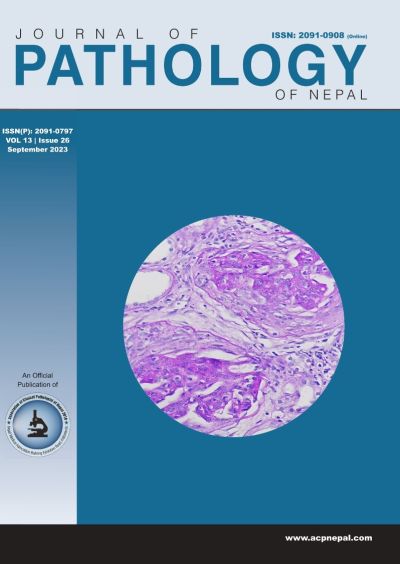Cytological grading of breast carcinoma and its correlation with histopathological grading
DOI:
https://doi.org/10.3126/jpn.v13i2.54568Keywords:
Robinson’s grading,, Breast carcinoma, Correlation of cytological grades, cytological grading of breast carcinoma, Elston’s modification of Scarff bloom Richardson grading, Mouriquand’s gradingAbstract
Background: Diagnosis of breast cancer is made in most of the cases near accurately by fine needle aspiration cytology. With the advent of neoadjuvant chemotherapy, the need for identification of aggressiveness of the tumor has become essential. So cytological grading may be of prime importance for the patient, who may undergo neoadjuvant therapy prior to surgical resection. Objective of this study was to grade the breast carcinoma on FNAC using Robinson’s and Mouriquand’s grading systems and to assess the concordance of both cytological grading systems with histological grading using a modified Scarff-Bloom-Richardson grading system.
Materials and Methods: This study was done between 2016 and 2018 in subjects with breast carcinoma undergoing FNAC. Cytological grading of the samples was done by Robinson’s and Mouriquand’s methods. Subsequent Histological grading was done on subsequent specimens according to the Modified Bloom Richardson grading system. Obtained histological grades were correlated with the cytological grades.
Results: Robinson’s grading system showed a significant association with the Modified Bloom Richardson grading system (p<0.01), with a specificity of 71.4% (43/60) whereas there was no significant association in the case of Mouriquand’s grading system.
Conclusions: Cytological grading of invasive breast cancer corresponds well with the histological grade. In our study, we found that grading a tumor by Robinson’s method was more specific and elementary compared to Mouriquand’s system of grading.
Downloads
Downloads
Published
How to Cite
Issue
Section
License
Copyright (c) 2023 The Author(s)

This work is licensed under a Creative Commons Attribution 4.0 International License.
This license enables reusers to distribute, remix, adapt, and build upon the material in any medium or format, so long as attribution is given to the creator. The license allows for commercial use.




